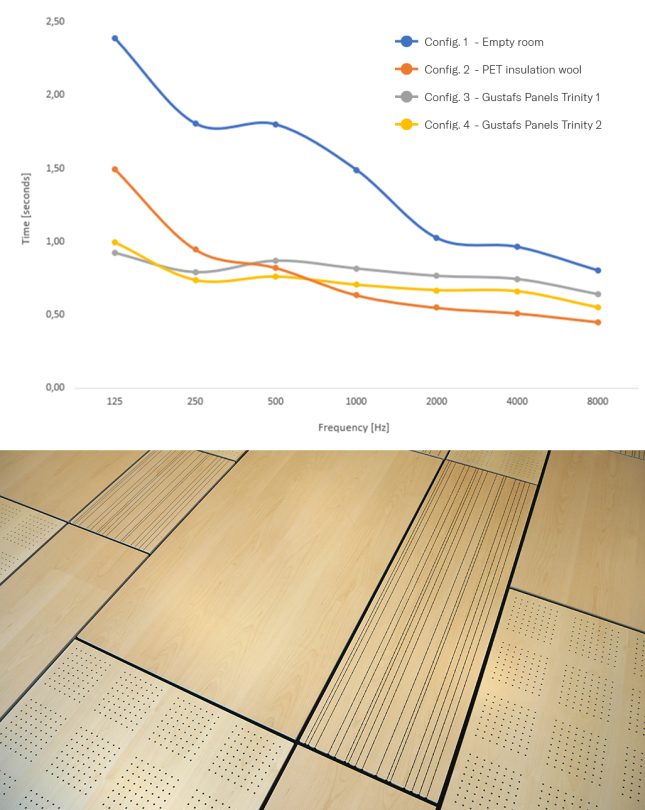Our latest news and views English
Underpinned by our Scandinavian design heritage, we bring you regular stories about architecture and interiors, exploring natural materials, acoustics, and the creation of safe and harmonious environments.
“Throughout my career as a professional acoustician, my goal has been to create rooms with natural sound characteristics. A current ambition is to discover an easily attainable solution that achieves a flat curve for reverberation times and diffusivity through a blend of acoustic panels with varying absorption coefficients.”
– Johan de Sousa Mestre

So, what defines and describes a natural sound? The essence of a natural sound, akin to the serenity of a mature forest, is characterized by a balanced diffusivity and uniform reverberation times across all frequencies. Drawing inspiration from nature and leveraging modern knowledge, we can engineer spaces with optimal room acoustics.
With relatively high diffusivity, a room is endowed with more softness and a greater sense of space. This achievement is a nuanced effort, that involves both technically calculated acoustics and holistic qualities we cannot compute. Some aspects of listener appeal can be likened to the natural allure of a forest, yet we must also incorporate technical features not found in nature.
The uniformity of reverberation times across different frequencies is a key metric that can be easily measured, as exemplified in the diagram below. Equal reverberation times are particularly essential in spaces designed for speech amplification and prolonged listening, minimizing listener fatigue, and enhancing fidelity.
Currently, most modern rooms exhibit low levels of diffusivity, as creating three-dimensional diffusivity often incurs substantial knowledge, especially in settings like schools. In my experiments I want to demonstrate that the optimal combination and placement of non-three-dimensional surfaces with varying acoustic absorption coefficients effectively can yield a high diffusivity. Compared to three-dimensional solutions, this approach is cost-effective and straightforward to implement. Moreover, the tested surfaces in our experiments result in a desirable flat curve for reverberation times, producing rooms that sound truly natural with optimal acoustics.

My experimentation took place in a room measuring 3.5 x 6.5 meters, resulting in a total volume of 59.1 cubic meters, like a meeting space accommodating 12-14 individuals. The room features three concrete walls, and one wall made of gypsum. Additionally, it includes two heavy doors, but no windows. The tests were conducted using a standardized room acoustic measurement procedure, measuring the room acoustics in several positions using a swept-sine stimulus.
The initial configuration represented an empty room. Reverberation times, illustrated by curve 1, indicated long reverberation and a far-from-flat curve.
In the second configuration, I added 10.8 square meters of PET insulation wool to the empty room. The insulation was 40mm thick with a density of 73 kg/m³ and was directly fixed to the ceiling in a rectangular shape measuring 3 x 3.6 meters at the centre of the ceiling. As shown by reverberation curve 2, this addition reduced reverberation, yet the curve still lacked the desired flatness.
In contrast to configuration 2, this setup covered the insulation wool with a combination of three different Gustafs panels within the same 3 x 3.6-meter rectangular area, without any additional air void. This combination, named Trinity 1, comprised non-perforated panels, panels with perforation RP8-Barcode, and panels with perforation PG5 (see photo). The reverberation curve now shows a high level of flatness, and with the addition of upholstered chairs, tables, and some more wall absorbers of this Trinity type, this space will effectively function as a high-quality meeting room.
Similar to configuration 3 but the Gustafs panels used in configuration 4 have another perforation mix Trinity 2, consisting of non-perforated panels, panels with perforation RP8-Barcode and panels with perforation RP8-C10. The result is very comparable to configuration 3 but with even slightly shorter reverberation times.
—————————
The diagram depicts measured reverberation times for the four different configurations. The ideal curve is flat, indicating uniformity across all frequencies. Configurations 3 and 4 exhibit the best performance in this regard. The image below shows the Trinity 1 perforation mix (Configuration 3).

Video animation made by Kalle Hedqvist at Akustikkonsulten.

My meticulous choices, including sub-area sizes, panel selections, and their placement, contributed to achieving a remarkably flat reverberation curve in the room. Listening in the room between the different measurement cases and analysing the room’s impulse responses showed an increased diffusivity for Trinity 1 and Trinity 2 compared to PET. Each experiment is unique in relation to the room used, the added materials that are selected, and how they are placed. It’s important to emphasize that the result is an outcome of all these factors.
While surface roughness traditionally creates diffusion, my tests have established that varying surface absorption is a practical alternative to enhance the diffusivity. The four configurations we tested demonstrated that a relatively straight-forward approach, utilizing a combination of flat and perforated panels, can yield excellent and natural room acoustics. We found that an installation depth of only 53 mm and 50% area coverage effectively achieved this result. Notably, this configuration left 50% of the ceiling visible, presenting an attractive alternative to the common practice of 100% ceiling grid coverage.
The selection of these solutions is rooted in my extensive experience gained through listening and measuring in a diverse array of room configurations. Furthermore, exceptional rooms with ideal acoustic properties have become increasingly rare, making my experience dating as far back as the 1990s invaluable.
Gustafs panels distinguish themselves by employing a core material with a high-density of 1200 kg/m³. These panels – depending on perforation type – exhibit a diverse array of characteristics that both reflect and absorb sound simultaneously. The tested configurations using the Trinity mix of Gustafs panels not only exhibited the desired flatness in reverberation but also high sound diffusivity. The result is a natural, easily audible sound that enhances speech and auditory experiences. For further insights into my Trinity tests, please do not hesitate to contact me.
Johan de Sousa Mestre has a long career of being a professional room acoustician and opera singer. His ambition is to achieve high-class room acoustics. He believes that his solutions make rooms pleasant to be in, and make people work more effectively. Johan is contacted at johan@akustikkonsulten.se or why not give him a call so you can discuss things! His phone number is +46-730-865800.
All photos: John Sandlund
